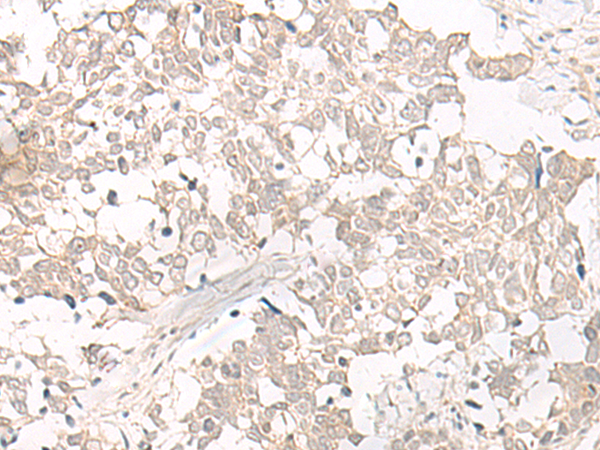
| WB | 咨询技术 | Human,Mouse,Rat |
| IF | 咨询技术 | Human,Mouse,Rat |
| IHC | 1/30-1/150 | Human,Mouse,Rat |
| ICC | 技术咨询 | Human,Mouse,Rat |
| FCM | 咨询技术 | Human,Mouse,Rat |
| Elisa | 1/5000-1/10000 | Human,Mouse,Rat |
| Aliases | DFNB36; LP2654 |
| Host/Isotype | Rabbit IgG |
| Antibody Type | Primary antibody |
| Storage | Store at 4°C short term. Aliquot and store at -20°C long term. Avoid freeze/thaw cycles. |
| Species Reactivity | Human, Mouse, Rat |
| Immunogen | Synthetic peptide of human ESPN |
| Formulation | Purified antibody in PBS with 0.05% sodium azide and 50% glycerol. |
+ +
以下是关于ESPN(Espin)抗体的3篇参考文献示例,基于Espin蛋白在听觉毛细胞中的功能研究:
---
1. **文献名称**:*Espin: Molecular mechanisms of actin filament regulation and hearing loss*
**作者**:Sekerkova G, et al.
**摘要**:该研究阐明了Espin蛋白通过稳定肌动蛋白丝参与耳蜗毛细胞静纤毛结构的形成,并开发了特异性Espin抗体用于小鼠内耳组织免疫荧光成像,证实其突变可导致纤毛结构异常与遗传性耳聋。
---
2. **文献名称**:*Antibody-based analysis of stereocilia plasticity in vestibular hair cells*
**作者**:Lelli A, et al.
**摘要**:作者利用Espin抗体标记前庭毛细胞静纤毛,发现Espin的磷酸化状态动态调控纤毛长度,抗体染色结果结合电镜揭示了其在机械转导中的关键作用。
---
3. **文献名称**:*Targeted disruption of the Espin gene causes abnormal microvilli-linked stereocilia and hearing impairment*
**作者**:Zheng L, et al.
**摘要**:通过构建Espin基因敲除小鼠模型,结合Espin抗体的Western blot和免疫组化分析,证明Espin缺失导致静纤毛发育缺陷及渐进性听力丧失,为遗传性耳聋机制提供依据。
---
注:若需具体文献原文,建议通过PubMed或Sci-Hub输入DOI/标题获取全文。实际引用时请核对作者、年份及期刊准确性。
ESPN antibodies target the Espin protein, an actin-binding cytoskeletal protein crucial for the development and maintenance of stereocilia in mechanosensory hair cells. Espin, encoded by the *ESPN* gene, stabilizes actin filaments by bundling them, enabling the formation of elongated, stiff protrusions in sensory cells. It is highly expressed in inner ear cochlear hair cells, vestibular organs, and testicular germ cells. Mutations in *ESPN* are linked to autosomal recessive deafness (DFNB36) and vestibular dysfunction, highlighting its role in hearing and balance.
Espin antibodies are valuable tools in auditory research, aiding in the study of hair cell structure, mechanotransduction, and associated pathologies. They are used in techniques like immunofluorescence, Western blotting, and immunohistochemistry to visualize Espin distribution in tissues. Researchers also employ these antibodies to investigate Espin’s interaction with other cytoskeletal components and its role in cellular signaling.
First characterized in the early 2000s, ESPN antibodies have since advanced studies on genetic hearing loss and vestibular disorders. Their development facilitated insights into how Espin mutations disrupt stereocilia organization, leading to sensory deficits. Ongoing research explores therapeutic strategies targeting Espin pathways, emphasizing its potential in treating hearing impairments.
×